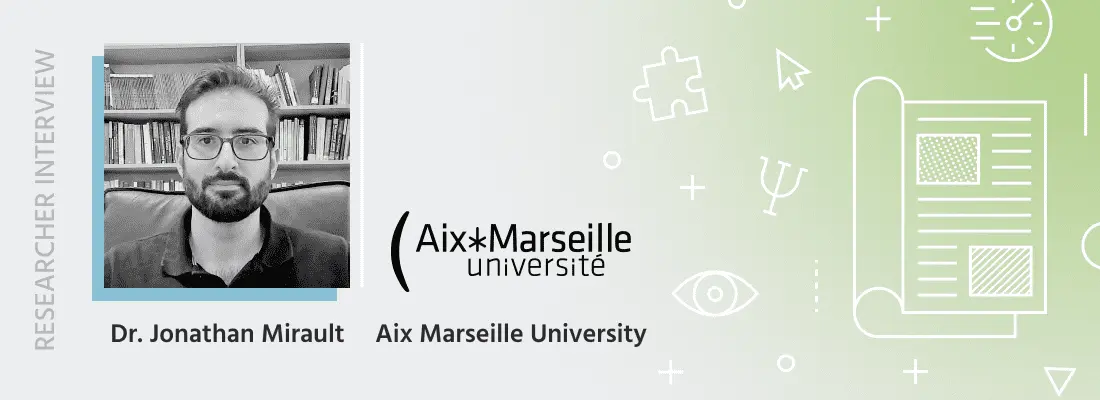
Orthographic relatedness and transposed-word effects in the grammatical decision task
Researcher: Dr. Jonathan Mirault, Aix Marseille University
In this interview, we discuss Dr. Mirault's research with grammatical and ungrammatical sentences bordered by distractor sentences. Check out the published paper here and read on to see his perspectives from this field.
Tell us about your research background and your field of study.
I hold a Master’s degree in Cognitive & Integrative Neuroscience and a Ph.D. in Cognitive Psychology. I am working on word identification and sentence reading, from the processing of orthographic information up to syntactic and semantic representations. I currently work as Research Engineer in experimentation and data analysis.
What motivated you to look into this area?
The understanding of the basic mechanisms involved in skilled reading and how this knowledge might help assist reading-disabled persons.
What are you currently working on or have recently worked on that you'd like to discuss now with us?
Current evidence suggests that when reading horizontally aligned text, information falling above or below the line of text being read does not influence reading behavior. Here we provide a further investigation of how information lying above and below a line of text being read can have an impact on reading, going beyond the typical single word vertical flanker manipulation.
Can you please describe the research design and how you set up the experiment?
We created 100 French 5-word sentences for the study. They ranged in length between 20 and 39 characters (including spaces) with words varying in length between 2 and 15 letters. For each sentence, we created another sentence formed of unrelated different words matched in word length with the target sentence. This formed the two levels of the factor Distractor Type (same vs. different). A Latin-Square design was applied such that participants were tested in both conditions but with different target sentences, and all target sentences were tested in both conditions across two groups of participants.
Across several experiments, we added other factors such as the lexicality of the distractors (words vs. nonwords) or simply the presence or absence of distractors (with vs. without). All the data (sentence, condition, item number, etc..) were merged into a .csv file and imported as a data frame.
Participants first read the instructions and then started with 6 practice trials followed by the main experiment after a short reminder of the instructions and the key press responses. A trial started with a fixation cross for 500ms centered on the screen. Then, the target sentence appeared centered on the fixation cross and bounded above and below by two distractor sentences (which were the same) at normal text spacing. Participants were instructed to read the target for comprehension and to press the space bar when then had finished reading the sentence. In some experiments, they had to press the right or left arrow to decide if the target sequence was grammatically correct or not. A gap of 200ms preceded the apparition of the next fixation cross. Target and distractor were presented in black on a light grey background. In order to ensure that participants read the target sentence for meaning, a yes/no comprehension question (e.g., is the cat grey?) appeared after participants’ response approximately every 10 items. Participants were instructed to ignore the sentences presented above and below the central target sentence. The presentation order was randomized for each subject (with the Trial_Id variable).
Tell us about your conclusion and the implications of that.
The present study examined the impact of stimuli lying one line above and one line below the line of text that was to be read by participants. Based on prior work with isolated words, we expected a negligible influence of distractor stimuli lying above or below the target word, contrary to the robust effects of distractors that are horizontally aligned with the target (e.g., Snell et al., 2018b). On the basis of work on visual crowding, however, we hypothesized that vertically aligned distractors should have some impact on reading, and that this influence might be best observable during sentence reading (as opposed to single word reading). That is, the impact of vertically oriented crowding might be negligible in single word recognition, but this impact might be observable when reading a complete sentence, given the cumulative impact over a sequence of words.
What are your next steps with this research?
The next step will be to use numbers as distractors to study the orthographic aspect (we did for lexical and grammatical aspects).
In what ways is conducting research online different from in-lab?
The main positive aspects are the greatly reduced delay in recruiting participants and the greater variability in the participants (age, native language, etc.) we can recruit.
Do you see online research as the future of your field?
For some aspects, yes. Particular attention must be payed to be sure that participants are strongly focused on what they are doing online. However, for experiments that require measures other than simple behavioral responses, such as physiological data, in-lab experiments will remain necessary.
How did you choose Labvanced for your research?
We chose Labvanced because it appears to be the easiest and most complete way to create behavioral online experiments. The possibility to add homemade Java scripts is also a plus.
What stands out to you about Labvanced?
The ease of use (creation and diffusion) and the data collection.
What would you recommend to students hoping to begin research in your field?
To not hesitate to look for experiments in the Library before developing their own scripts.
Do you have a message to share with other Labvanced users?
The creation of a forum for helping each other could be great for sharing knowledge.